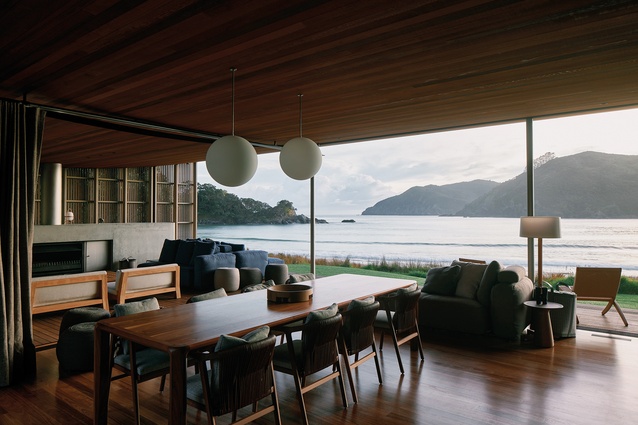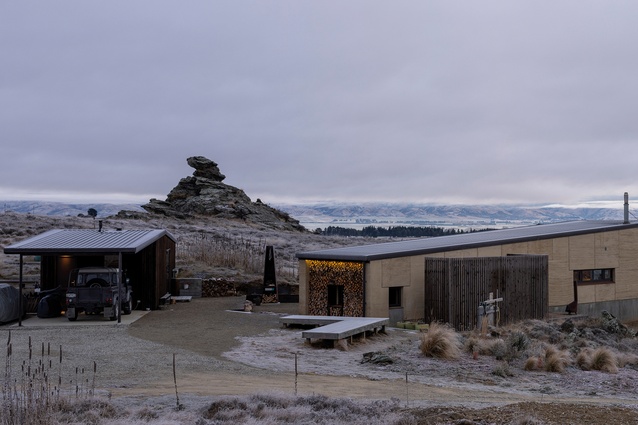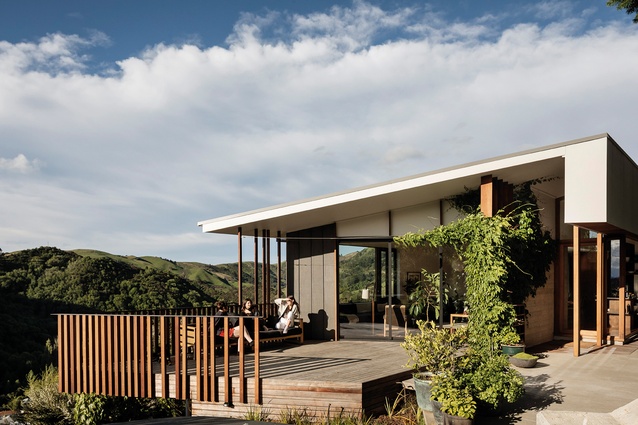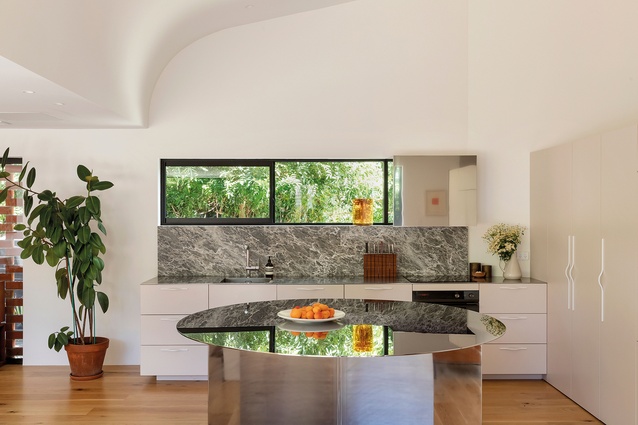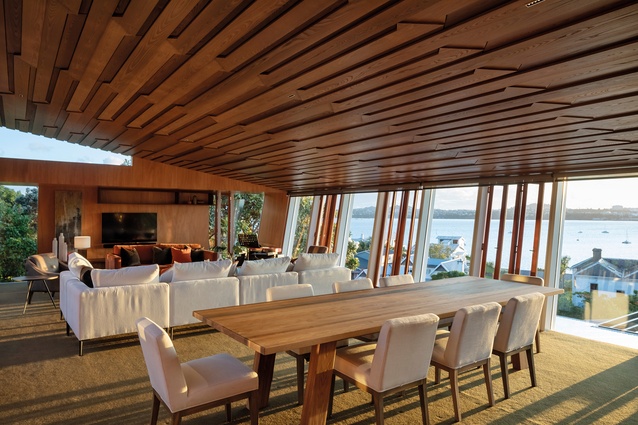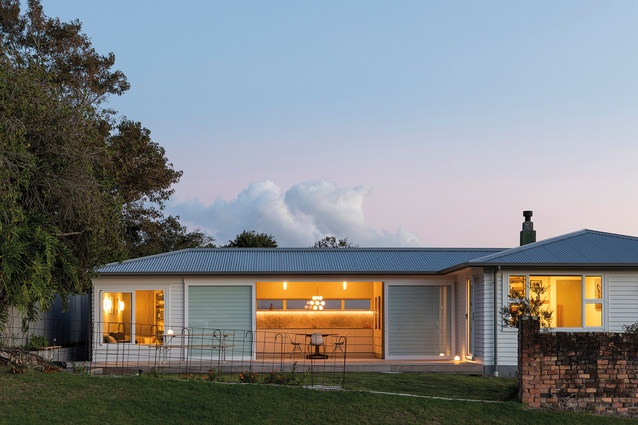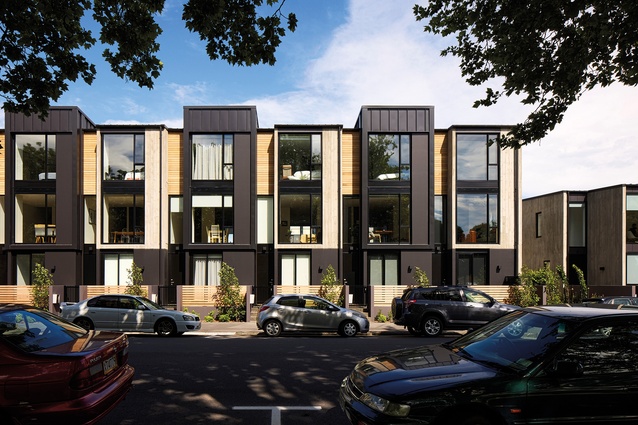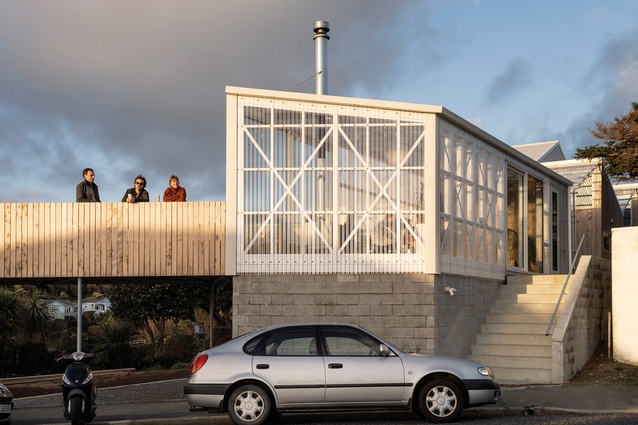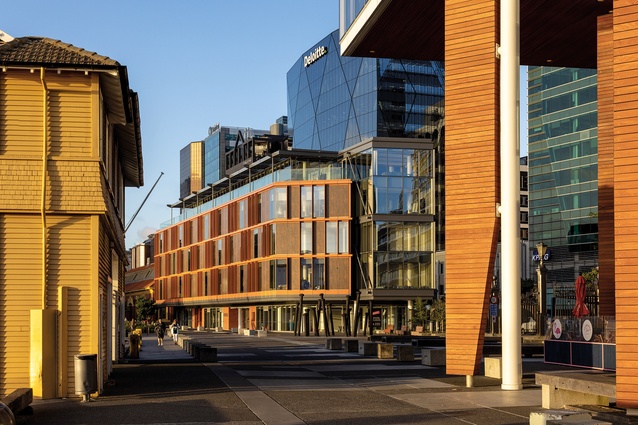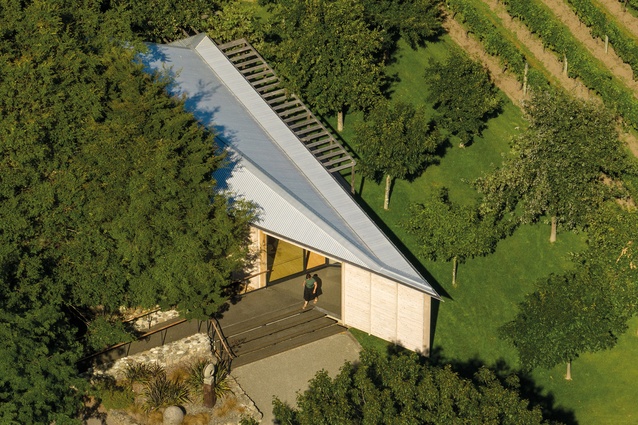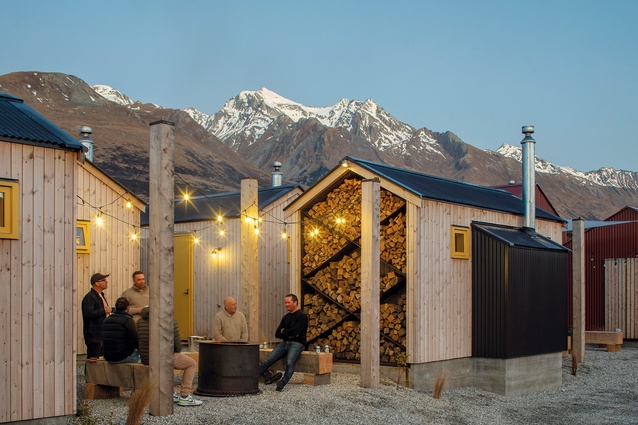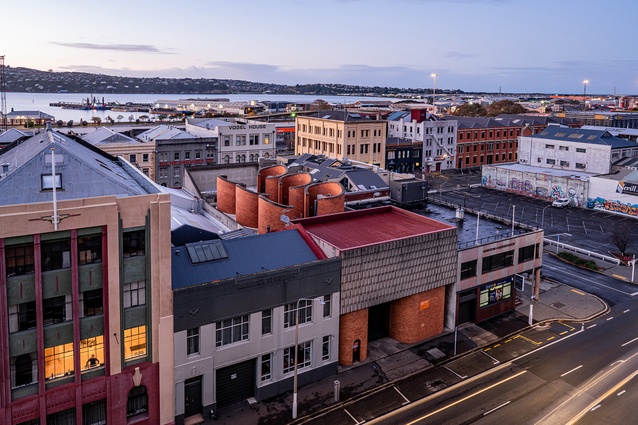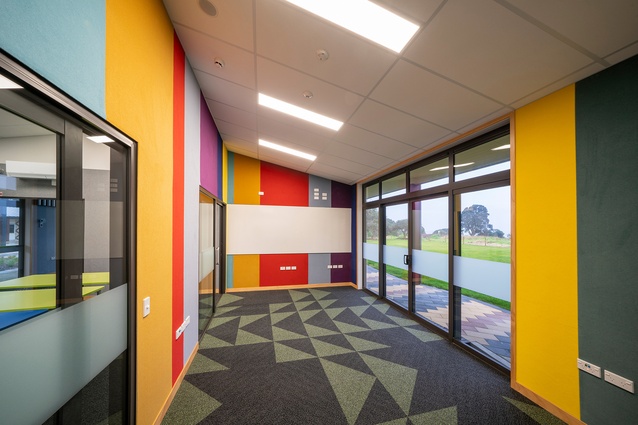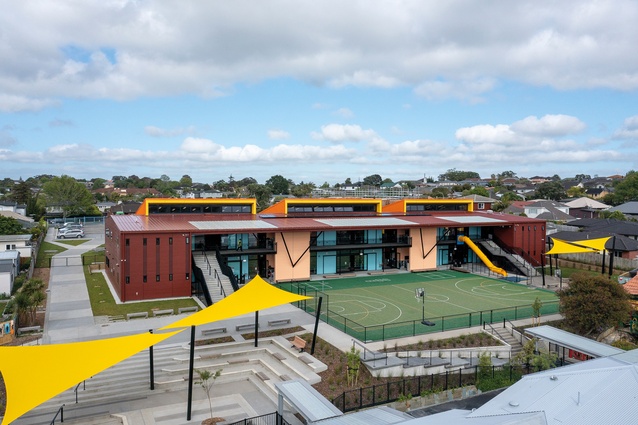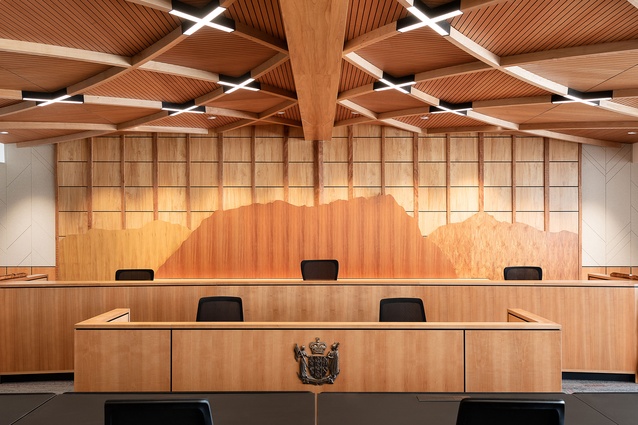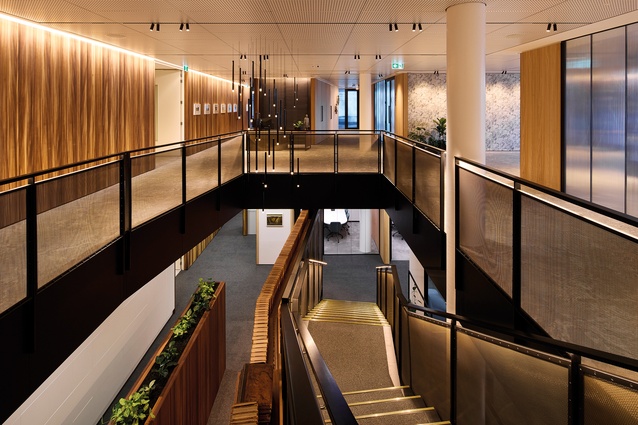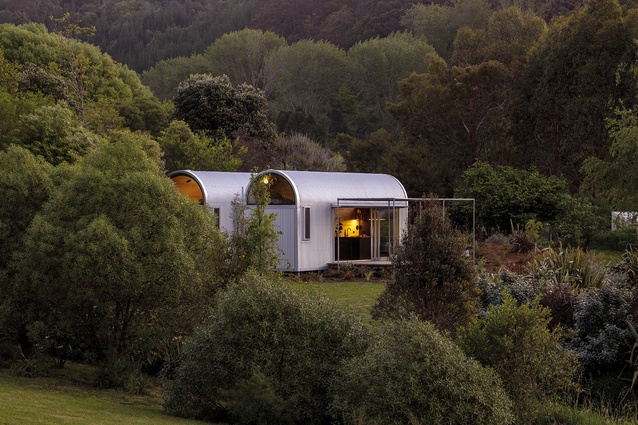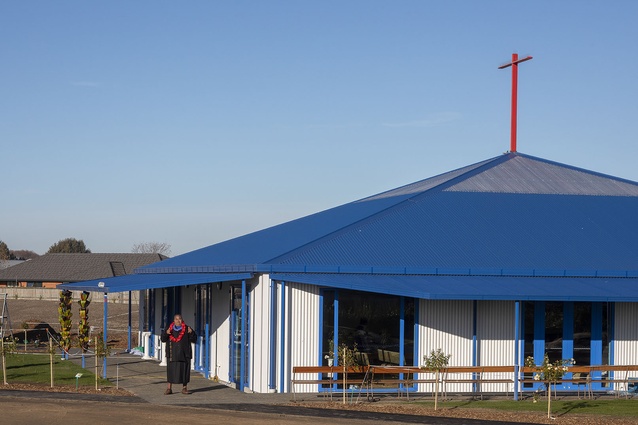Winners announced: 2023 New Zealand Architecture Awards
Te Kāhui Whaihanga New Zealand Institute of Architects (NZIA) has announced the winners of this year's New Zealand Architecture Awards.
This year’s New Zealand Architecture Awards jury was led by 2020 Gold Medal award-winning architect Dave Strachan of Tāmaki Makaurau Auckland-based practice Strachan Group Architects.
Strachan was joined by Sally Ogle of Patchwork Architecture and Ewan Brown of Tennent Brown Architects, both of Wellington Te Whanganui-a-Tara, and guest international juror and past President of the Australian Institute of Architects Clare Cousins, from Melbourne, Australia.
The jury visited 61 short-listed projects across 13 categories during late August and early September.
Said Dave Strachan, convenor of the jury: “It was a marvellous experience to travel some serious distances over 13 days, proudly show our Australian juror Clare many people and places in Aotearoa, and burn up a lot of hours together. Sally Ogle brought along erudite analyses of projects, asking probing questions and always driving for small over big, as is evidenced in some of this year’s award-winners. We were very lucky to have an Ozzie rock star on board in Clare Cousins; she was our iPad scribe, very quick to note key elements of each project, and she shared her Melbourne experience and that classic antipodean sense of humour. Ewan Brown kept us on track, keeping the projects honest. He was our Orwellian ‘Ministry of Truth’, calculating$/m2 rates, while analysing carbon statistics, energy and resource use.
From what we observed, a few architects need to brush up on how they tell those sustainability stories. Most architects realise that we must address environmental challenges better than we have done in the past. We generally felt that some projects needed more focus in the area of sustainability. Of course, larger-budget jobs have greater capacity to deal with that, in both capital expenditure and special consultants, but we saw some exemplary small projects in terms of energy and resource use, and building resilient communities. These projects showed us that less really can be more.”
View all of the winning projects in the slideshow above, and read on for the jury citations:
HOUSING AWARDS:
Ophir House by C Nott Architects

Judges said: “This relaxed, unfussy house sits comfortably in the high alpine desert of Otago, emerging from the grasses to give its occupants a vantage over the landscape below. A range of tough, durable and tactile materials, including rammed earth walls and a polished earth floor, have been carefully crafted throughout. The formal arrangement gives height and generosity to living spaces, and low, cosy comfort to the sleeping space. The secondary building, containing guest accommodation and work space, defines an exterior courtyard, which extends the relatively modest floor plate of the internal spaces.”
Omata Beach House by Herbst Architects
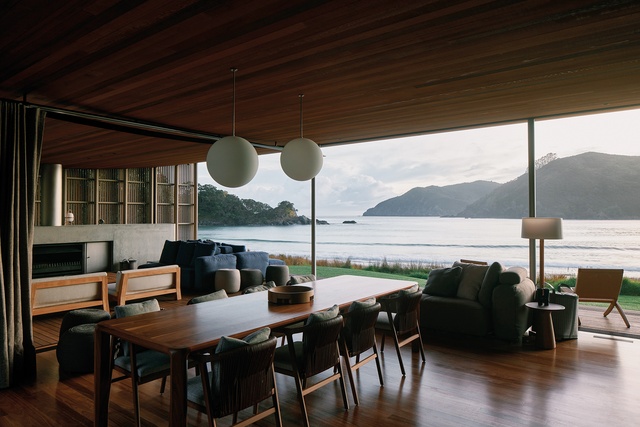
Judges said: “The jury was impressed by this beautiful, carefully detailed home, which has clearly been designed with consideration of how it is occupied throughout different seasons and times of the day. The operability of the house allows for sun and wind to be modified in the living spaces. Internal courtyards provide a strong connection to the landscape, while maintaining privacy for those in residence. Highly crafted joinery is seamlessly integrated into the building and other materials selected provide a tactile reminder that this is a beach house, with local stone used for floors and robust timbers throughout. Small moments like foot washing basins located around the exterior hint at a thoughtful, well-used and practical family home.”
Feather House by Irving Smith Architects

Judges said: “This house is evidence of the clear understanding, trust and collaboration between architect and client, and a testament to the results that can come from continued prototyping and testing throughout design and construction phases. Strong diagonal circulation zig-zagging through the house creates a series of flexible living spaces both inside and out. The deconstructed bathroom further enhances the flexibility of the planning, allowing this house to comfortably accommodate two people, or an extended family. The house is well settled into its site, with the in-situ concrete walls defining further ‘rooms’ and circulation between the building and hill. Details are sophisticated and beautifully crafted throughout, with bespoke designs making the most of the fact that the owner was also the builder and knew exactly what was needed to create the perfect dwelling. This is a beautiful, welcoming and hospitable house.”
Brick House by Sayes Studio
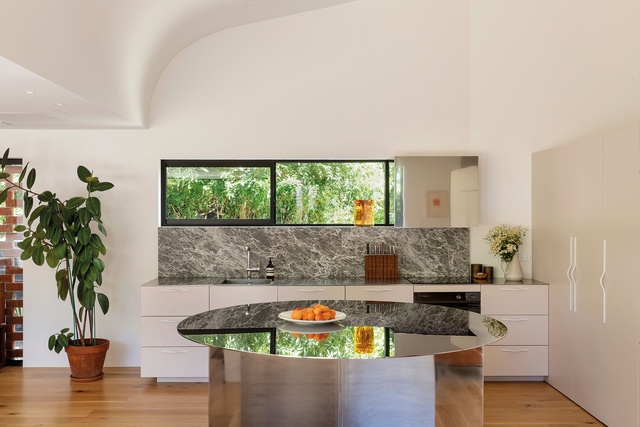
Judges said: “This is an architecturally ambitious house, which delivers generous and delightful spaces on a very tight budget for its occupants. The design responds skilfully to the constraints and opportunities on the site, with the key formal move to create two distinct zones: a lofty living space opening to a sunny outdoor area, and bedrooms above the entry and garage. This house proves that prosaic, cost-effective materials — including brick and gib most often seen in spec houses — can lead to a delightful outcome. The round chrome kitchen island, and curving stair handrail fabricated of plumbing pipe, deserve special mention as surprising, well-considered design solutions. As one of three (or maybe even four) houses that will eventually be built on this site, Brick House serves as an example of how successful residential density can be achieved in our cities of the future.”
See-Saw home by Upoko Architects
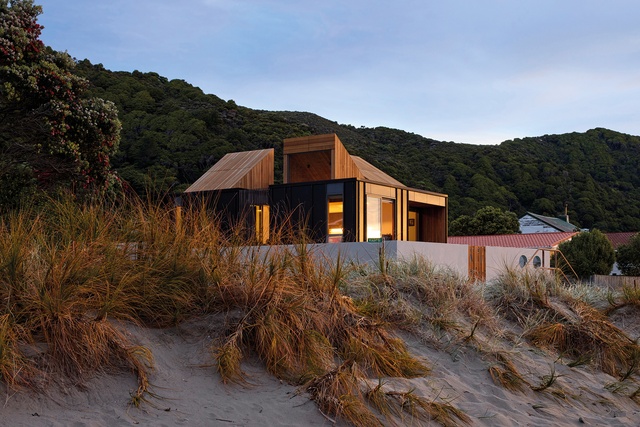
Judges said: “The jury were extremely impressed by the way this house is positioned on a very public and exposed site adjacent to the beach. The house actively engages with the street, while layering spaces for the occupants to maintain privacy; the main bedroom in particular has been skilfully handled, allowing for separation from the street and living spaces, but retaining sea views through an internal courtyard. Careful consideration has been given to how light and sun enter the house throughout the day, with pop-up roofs utilised to inject sun deep into the centre of the house. The screened internal courtyards allow for ventilation without completely opening up to prevailing winds, and maintain security while allowing for the flinging open of doors. Simple materials have been carefully detailed throughout, making this a small but generous and joyful home.”
HOUSING – ALTERATIONS AND ADDITIONS AWARDS:
Keene Family Home by Bull O’Sullivan Architecture

Judges said: “A relatively unchanged street façade opens up (and up and up) to an extensive addition behind this project, skilfully managing the planning of a large house on a 40° slope, and in close proximity to neighbours on either side. The alteration achieves expansive views from each level and a surprising amount of outdoor amenity, including sheltered courtyards and a pool at the apex of the site. The palette of materials inside and out includes native timbers, woollen carpets, and cork which are sympathetic to the original house, but distinct from the white façade of the exterior and the neighbouring dwellings. This project is extremely responsive to the brief from the family — a physical copy of which is framed on a wall in the home office — with most requests highlighted and ticked off; clearly happy clients.”
LANCASTER - The Luxury of Enough by Lloyd Hartley Architects
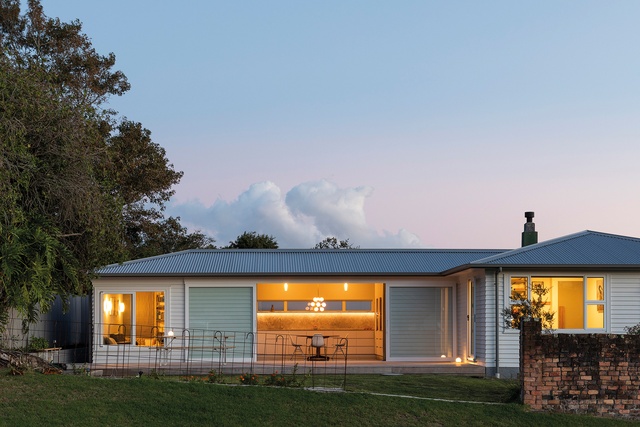
Judges said: “This project does so much with a very modest budget, turning a very small cottage into a slightly larger, but significantly better home of 135m2. The jury was impressed with the considered planning, which ensures the liveability and adaptability of the modest spaces for a family of five, and brings light into the house. Square meterage is prioritised in the communal spaces, where life is lived, while children’s bedrooms are smaller (and crucially, all identical) spaces. There are thoughtful details throughout, often created using generic and economic materials in a considered and crisp way. Occasionally a bespoke intervention offers something extra and delightful. This project is the result of an owner-architect carefully working through the specifics of his own family’s daily routines and occupation of space, producing a calm and robust house perfectly suited to their life.”
Kelburn Villa Alterations by Mary Daish Architect
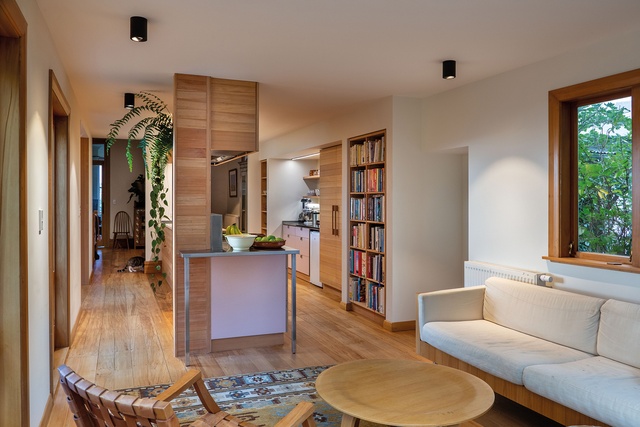
Judges said: “This alteration is one of minimal interventions, handled by the architect in an extremely skillful way that pairs the existing character of the villa with highly considered contemporary interventions. The addition of a few square metres, some re-planning, and dealing with a few weathertightness and maintenance issues was accompanied by infilling a small portion of the upper-level verandah. This not only solves pragmatic concerns of entry and storage, but also creates a generous kitchen and defines a private balcony beyond. Material choices, including Western Hemlock panelling, complement the existing timber in the space and add warmth and a feeling of comfortable domesticity. The result is a lovely, liveable home suitable for the next 50 years of occupation, and clients that are delighted with the results.”
HOUSING - MULTI UNIT AWARDS:
Fletcher Living - Worcester Terraces by Sheppard & Rout Architects
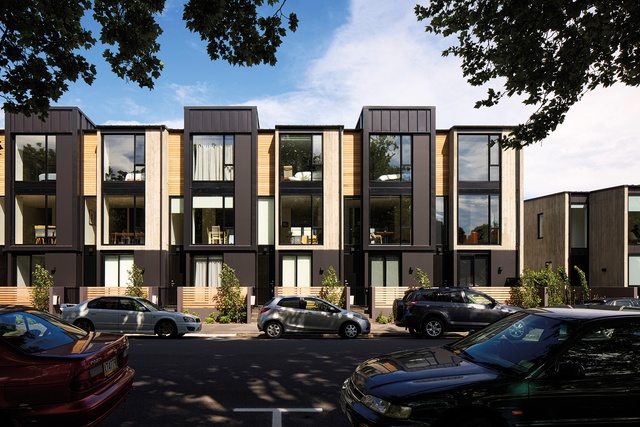
Judges said: “This is a large-scale, medium-density development with a commitment to quality evident throughout, both in the buildings and site works. The approach allows for a strong street presence, one that is not dominated by cars and garaging. A mixture of typologies and varied forms and material treatments enhances this presentation to the city and the jury commends the consideration by the design team of how, with the internal courtyard currently given over to car parking, the site might adapt to a common green space in the future. Although there is high usage of carbon-intensive concrete, the precast panels have been used to maximum advantage as structure, finish, fire and acoustic separation, and will ensure this development is durable. Within the units, the experience of the occupants is paramount; these are comfortable homes thermally, acoustically, and spatially. Dual aspects allow for cross ventilation and a variety of inner-city views.”
Block Party by Spacecraft Architects
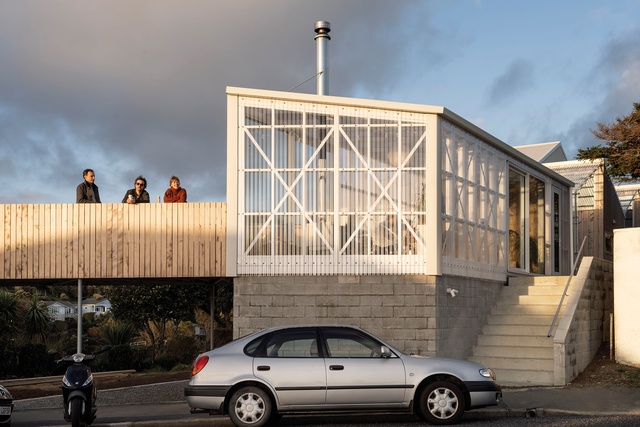
Judges said: “This co-housing project containing four houses is a well-considered, straightforward design that is generous to its occupants while keeping the limited budget front of mind. Each of the four houses feels spacious despite a compact interior floor area. Covered entry porches and secure storage spaces add significant functionality, and shared spaces including garden, laundry, and the large party room act to extend the individual dwellings. The transition from communal and public spaces through to each unit, and between additional outdoor spaces, is deftly handled, and ensures both connectedness and privacy in equal measure for the occupants. Personalisation of each dwelling is created via simple changes in finishes, ensuring construction complexity is minimised. This project makes the most of the site’s opportunities, sits comfortably and politely alongside the neighbouring single residential properties, and is an exemplar for increased density in our cities.”
COMMERCIAL ARCHITECTURE AWARDS:
Site 9 Kumutoto by Athfield Architects

Judges said: “This project on Wellington’s waterfront is a standout example of a response to a difficult site with architectural ingenuity and sensitive urban design. Careful modulation of form and façade blends seamlessly with the maritime and historical context of its surroundings. Built on a site initially thought too small to be developed, innovative engineering solutions allowed the addition of a discreet fifth floor, making the project economically viable. The design also overcame complex site conditions and planning constraints, which challenged the team, making the result even more successful. The project also excels in material durability, clever internal planning, and a well-thought-out interface with public realms, making it a notable addition to Wellington’s evolving waterfront landscape.”
WallÉ by Irving Smith Architects
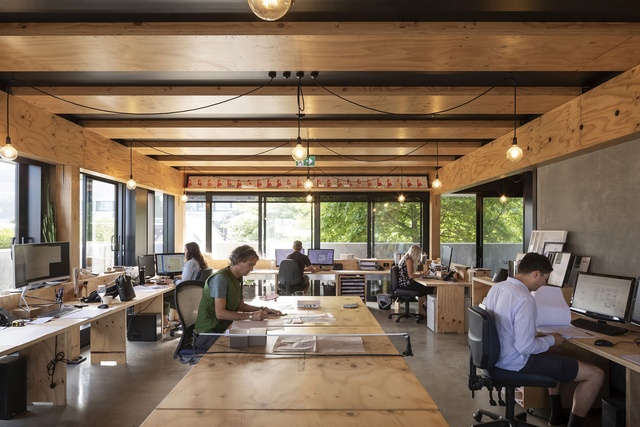
Judges said: “WallÉ is an office building that takes inspiration from nature, using architectural elements to mimic trees and jungles. Situated in a small central city site, it maximises the space by using precast concrete for the ground level and lighter materials for the upper levels. The design innovatively complies with fire code requirements by recessing glazing on the mid-level, allowing generous perimeter glazing for ample natural light and ventilation. WallÉ serves as a model for future timber construction in small commercial settings, utilising structural solutions like structural LVL frames and lightweight Potius flooring. It is not only a functional owner-operator office space but was achieved on a budget that shows the viability of the architect-as-developer approach.”
HOSPITALITY AWARDS:
Ata Rangi Tasting Room by Makers of Architecture
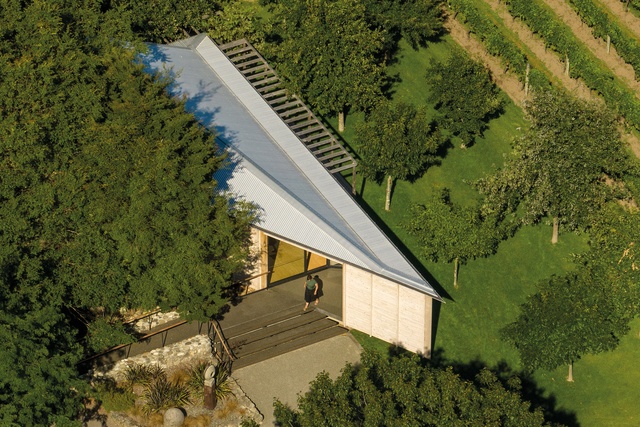
Judges said: “Setting a tranquil wine-tasting facility amongst vineyards and a collection of buildings inspired a triangular form as a response to the existing built environment. The resulting dart, narrower at the carved-out entry, then expanding toward the back-of-house areas, is both dynamic and yet tempered by plaster textured walls, the sight and smell of locally sourced lawson cypress, and views out into the vineyard. Architect, builder and client have all sung from the same song sheet and it shows in this elegant, superbly executed building.”
The Great Glenorchy Alpine Basecamp by RTA Studio and Bureaux
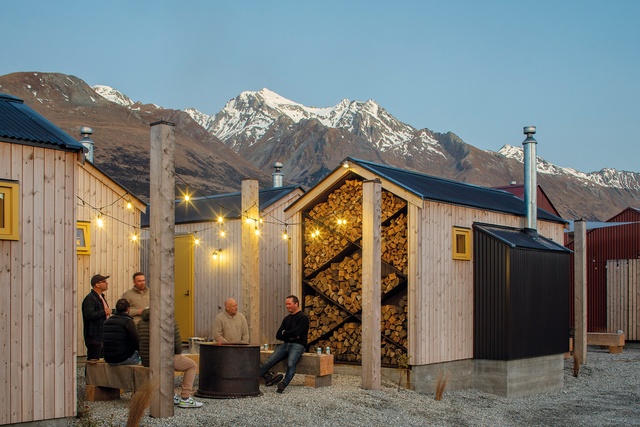
Judges said: “Architecture that sits on the doorstep of a UNESCO World Heritage Site has to deliver an appropriate response to context. Fourteen simple, gable-roofed sleeping huts and adjacent communal spaces are built from mainly locally sourced materials and have a low embodied and operational energy footprint. Inspired clients, together with the architects, interior architects and builders, have created a true fit not only to place, but offer the best pre- and post- experiences for visitors engaging with this powerful landscape.”
Flockhill Homestead by Warren and Mahoney Architects
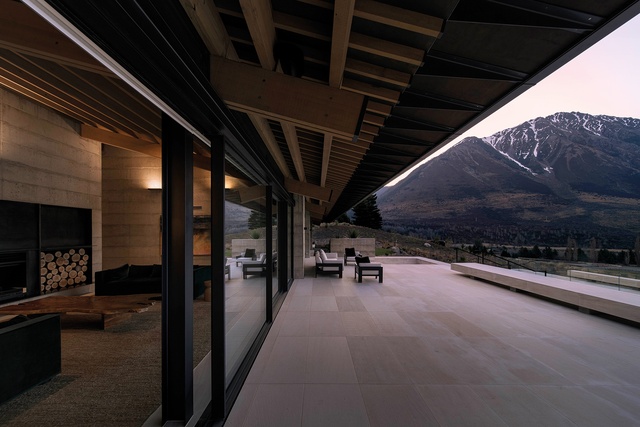
Judges said: “Looking northward to Lake Pearson and the surrounding mountainous landscape, this high-end hospitality offering takes its cues from local farm buildings. Robust and durable coloured in-situ concrete, cast in striated layers, anchor the collection of buildings to the site. Although concrete is high in carbon, this is tempered by extensive use of locally sourced timbers on walls and ceilings. Public and private spaces are well defined, and a large farmhouse-style kitchen offers either groups or individual guests to meet and connect over a meal. A lazy gabled roof form with a fine outer edge and highly detailed sheltering verandahs suggests rest and repose. Passive design principles are to the fore in this elegant shed.”
ENDURING ARCHITECTURE AWARD:
Southern Aurora Substation (1972) by Allingham, Harrison & Partners

Judges said: “Utilitarian buildings, by their very nature, often go completely unnoticed on their sites, or don’t warrant a second look. Here, the upper, fluted precast façade, placed over a beautifully detailed, curved brick vehicle and pedestrian entry with mesh security screens, sits up proudly and says, ‘look at me’. On the upper-roof level of the 1972 substation, curved brick screens hide the necessary transformers, while essential electrical requirements are hidden away in the basement and ground floor bunkers, ensuring there is light and power for the region at the flick of a switch.”
Erskine Building, University of Canterbury (1998) by Architectus, Cook Hitchcock Sargisson and Royal Associates in association

Judges said: “The Erskine Building at the University of Canterbury is an enduring paragon of architectural innovation and functionality more than two decades after its completion in 1998. Still visually striking and highly functional, the building has proven the enduring relevance of some of the most progressive architectural ideas of the 1990s. Notable for its innovative sustainability features like displacement ventilation and passive ventilation in academic offices, the structure also incorporates curved precast ceilings and a glazed atrium that was ahead of its time. Spatial design features include collective academic clusters and breakout areas that facilitate good circulation and communal interaction. As a structure that predicted and solved many contemporary architectural problems, the Erskine Building is as equally relevant 25 years on as it was on completion.”
EDUCATION ARCHITECTURE AWARDS:
Te Aratai College by Architectus

Judges said: “Located in east Christchurch, Te Aratai College is a rebuild of the former Linwood College. It succeeds through its design emphasis on student success and broad community engagement. The campus layout is characterised by clear spatial planning that includes a civic space, dual courtyards, and an ‘avenue of learning’. The design, which acknowledges the multicultural makeup of the school, successfully fosters a sense of community by offering a well-considered balance of privacy and openness and by injecting sunlight through strategically placed windows. Durable, low-maintenance materials were selected, a nod to the site’s challenging ground conditions.”
Te Kura o Te Whānau a Apanui by DCA Architects of Transformation and MOAA Architects in association

Judges said: “The success of any kura is critical to empowering our future generations. Those who are lucky to work and study here will connect with their whakapapa and be enriched by the experience. This project is an exemplar of how to meet adversity head on and with tenacity, consultation and understanding from the 13 Hapu; it has resulted in a rich environment for a very proud Iwi. Three gable roof forms with generous verandahs have their ley-lines oriented to places of significance and tell the story of the three schools, previously stretched over many kilometres of coastline, that have combined to become one. The careful relocation of four existing Pou, together with paving, screens, carving and brickwork treatment, continue a strong narrative about this very special place.”
Owairoa Primary School by RTA Studio

Judges said: “On a site bordered on three sides by residential dwellings (creating more restrictive controls), the architects have, by cutting into the southwest slope, created a two-storey building, allowing more space at ground level for outdoor activities. Planning is deceptively simple, providing a variety of quiet and more active spaces. The treatment of the façade, utilising robust materials, varies depending on orientation, and deep, north-eastern verandahs and clerestories together with cross ventilation provide a passive response to climatic conditions. An extensive colour palette creates a practical, yet playful space for the young students and their very happy teachers.”
HERITAGE ARCHITECTURE AWARDS:
The Hayman Kronfeld Building by Peddle Thorp

Judges said: “The Hayman Kronfeld Building, located in Auckland’s Britomart Precinct, is an innovative example of adaptive reuse, merging two Grade A heritage-listed buildings into one modern, compliant office space. The project skilfully negotiates structural challenges, like floor height disparities, through the inventive use of a lift core and also showcases skilful fire risk and acoustics management. Alongside modern elements, the project incorporates significant heritage restoration components, including the thoughtful use of salvaged bricks and period-appropriate materials. The building interior is enhanced through thoughtful internal and external lighting strategies and sets a strong precedent for urban design, extending its impact well beyond its footprint.”
Dorset Street Flats by Young Architects
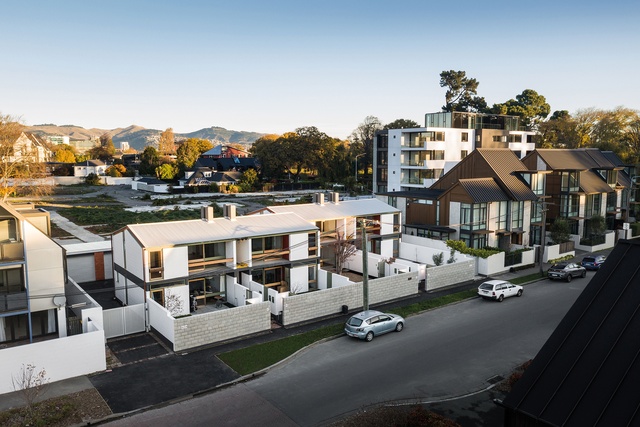
Judges said: “This is an extraordinary project to preserve and revitalise a significant piece of New Zealand’s architectural history. Initially aimed at repairing earthquake damage, the project eventually shifted to upgrading the flats to modern living standards, while respecting their heritage status. The jury was impressed by the architect’s determination to save the building from demolition (which was proposed by insurance companies), praising their ‘amazing tenacity’ and ‘extremely sensitive major interventions’. The project also received commendation for enhancing thermal comfort, making the flats models for small-space living. Notably, the restoration had the support of its tenants and serves as a mid-century example of co-housing, further justifying its preservation.”
INTERIOR ARCHITECTURE AWARDS:
Faradays by Cheshire Architects

Judges said: “Challenging the norms of how retail spaces should look requires skill and a willing client, particularly when it involves getting sign off from elite global fashion brands. To then add a florist and wine bar to the retail space appears to ignore the conventional rule book. Here, the rawness of the existing historic building provided a perfect backdrop for the playful stretched cotton canvas laid out in a sinuous curve, sometimes tought, sometimes pulled apart, to reveal merchandise. Highly crafted bespoke plinths, benches, counters of stone, timber, plaster, lacquered MDF and glazed cabinets all combine to create a playful, comfortable and effective retail experience.”
Whangārei Māori Land Court, Te Kooti Whenua Māori by GHD Design and Studio Pasifika in association

Judges said: “This civic building is a vital hub for judicial decisions and ancestry records related to Māori land. The courtroom design provides a strong example of how changes in an institution’s kaupapa can be reflected in its architecture. The design is centred on the principles of mahi toi (art and craft), ahi kā (continuous occupation), tohu (guidance), and whakapapa (ancestry), and integrates modern architecture with traditional Māori elements. The interior spatial design addresses issues of hierarchy by fostering a sense of equity, participation and inclusion. Key features include a lowered bench for the judge, a woven timber ceiling with cross lighting, bespoke fabric and acoustic panelling, and a carved wooden cloak placed on the judge’s bench that encourages direct interaction with visitors. The design successfully merges traditional craft with modern technology, making the courtroom approachable and accessible while also fostering dialogue and addressing past relationships.”
Chapman Tripp Wellington Fitout by Studio of Pacific Architecture
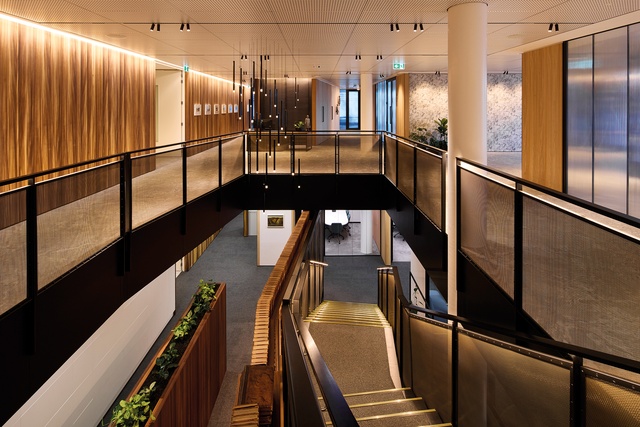
Judges said: “This project is testament to the effectiveness of strong communication and organisation between client, architect and contractors during the difficult COVID 19 lockdown period. A clear metaphor of light passing from the darker hills to lighter seascapes has resulted in a dark to light material palette within the two-storey floor plates. A central void and stair linking business clients and guests on the upper level and in the workspaces below, activates the space and allows a double-height library wall to stand proud and add gravitas to the work carried out here. This beautifully detailed fitout has resulted in a higher percentage of the team wanting to swap from WFH to being in the office — surely a marker of success.”
SMALL PROJECT ARCHITECTURE AWARDS:
Te Pae by Crosson Architects

Judges said: “Aotearoa’s wild West Coast has claimed many lives over the years, making a fit-for-purpose lifeguard tower a critical piece of the community’s infrastructure. With a history of their towers succumbing to the extremely harsh marine environment, form and material selection were paramount for the largely volunteer surf life-saving teams. The selection of black oxide precast circular concrete pipe sections stacked upon each other, not only deflects the wind, but provides a strong response to the context of the local black sands. A very functional and safe spiral staircase leads to the cantilevered watch house, its operable ribbon windows, like a pair of wrap-around westie sunglasses, providing views up and down North Piha’s rugged surf coast.”
Studio House by William Samuels Architects
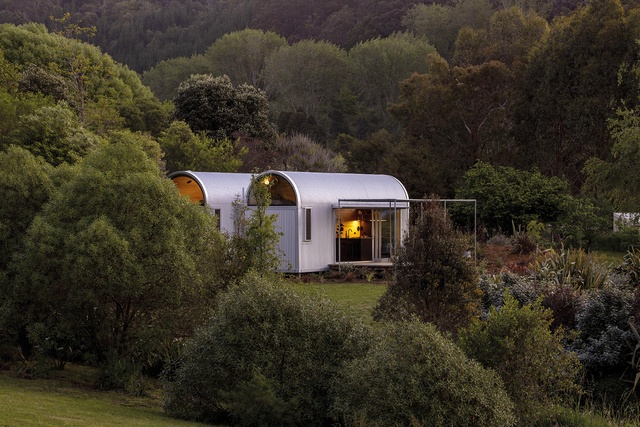
Judges said: “Studio House is a small and extremely well-considered home. Conceived as a relocatable and extendable dwelling, and located on family land, it allows its occupants (who were both designer and builders) to have the security of home ownership without the expense of land. The slipped planning of this dwelling eliminates circulation, and provides a sense of privacy for the bedroom and bathroom spaces within the small footprint. The deck becomes an extension of the interior space, both physically and visually. Significant storage is provided throughout, ensuring this house is an excellent demonstration of how to live small but generously. The ability to relocate this dwelling, or to add a third module in time, has been carefully and realistically considered in the design, adding future flexibility. It is a delightful project that illustrates how the ‘tiny house’ concept can be executed as a highly resolved architectural project.”
PUBLIC ARCHITECTURE AWARDS:
Fonua Mana by Bull O’Sullivan Architecture

Judges said: “Despite an incredibly modest budget, this building is worth millions to its Pasifika community. The architects have set the building on a diagonal axis oriented north, with deep verandahs peeled away at the corners to allow controlled sunlight in; a soaring dark, cork-lined ceiling, translucent at its apex, allows light to filter through Tapa cloth into the heart of the space. The utilitarian blue corrugate pyramid roof is topped by a vibrant red cross. In the words of one of the community leaders, ‘the happiest people don’t have the best of everything — they make the most of everything’, and this building is a testament to this notion.”
Te Huhi Raupō Renal Unit Taranaki Hospital by Warren and Mahoney Architects
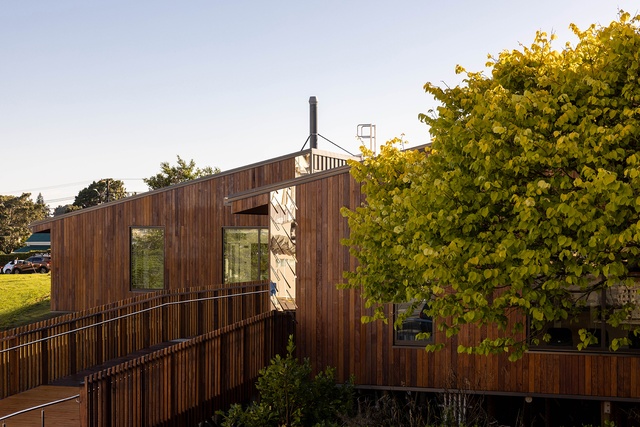
Judges said: “This hospital unit steps outside the conventional language of healthcare architecture to set a new benchmark for sustainability and patient experience. Spacious and light-filled, with extensive use of sustainably sourced timber, the unit forms a bridge and spans a valley planted with natives, connecting the hospital with the street and the surrounding landform. The warmth of the materials used throughout imparts a natural, relaxed and non-institutional aesthetic, with a sustainability framework that includes zero carbon and zero energy design. Built to offer patients a ‘sense of hope, relaxation and access to nature’, it ensures that dialysis treatment is delivered with ocean views and generous sunlight. Design input from local iwi has instilled a narrative into the building that communicates the story of wai (water) as a life-sustaining force integral to the human body and the community’s well-being.”
Te Pae Christchurch Convention Centre by Woods Bagot in association with Warren and Mahoney Architects
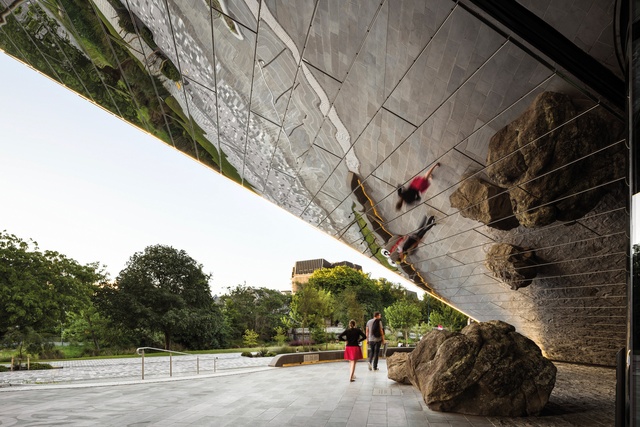
Judges said: “A significant part of Christchurch’s recovery and redevelopment after the 2011 earthquake, this building is designed to integrate with the city’s new urban sensibility. It celebrates the region’s pre-colonial and multicultural heritage and provides a strong cultural presence for local Ngāi Tahu | Ngai Tuahuriri. The project stands out for its focus on community building, rather than on being just a ‘big box’ convention centre. It offers easy access to the Avon River and creates a civic space that can host up to 2000 delegates. The design faced several constraints, notably the complex façade and seismic loading, but these were overcome through innovative and collaborative efforts. The jury praised the strong, warm timber interior and the clever management of people flow in the spaces, and deemed it a very successful piece of civic architecture.”
PLANNING AND URBAN DESIGN AWARD:
Ngā Hau Māngere — Old Māngere Bridge by Bossley Architects
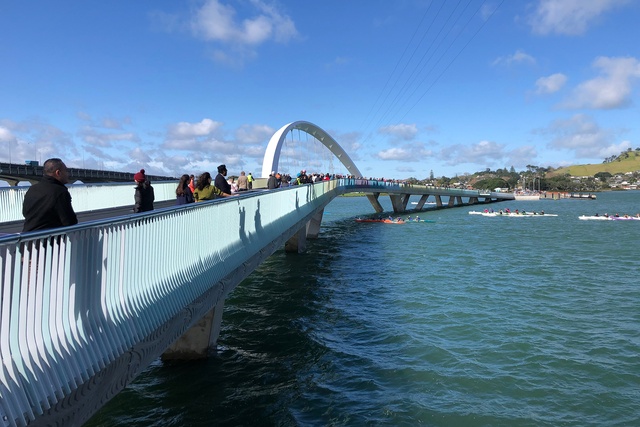
Judges said: “Ngā Hau Māngere is a successful marriage of community-engaged design and engineering. Replacing a century-old crossing, the new structure serves as a social hub that promotes active transport and community gatherings. Developed in partnership with Mana Whenua and guided by public feedback, the bridge bends mid-span to change the traveller’s mid-journey view of their destination, offers views of the maunga (mountains) at either end, and provides generous space for pedestrians, cyclists and fishers, with inbuilt seating and rod holders. It has quickly become a local aesthetic treasure, with an inclined steel arch creating a visual link between the upper and lower harbour, and a colour gradient referencing fish scales that change as the traveller moves across the span.”
The New Zealand Architecture Awards receive generous support from Resene, a steadfast sponsor of the program since 1991, and APL, which commenced its sponsorship of the awards in 2021.

